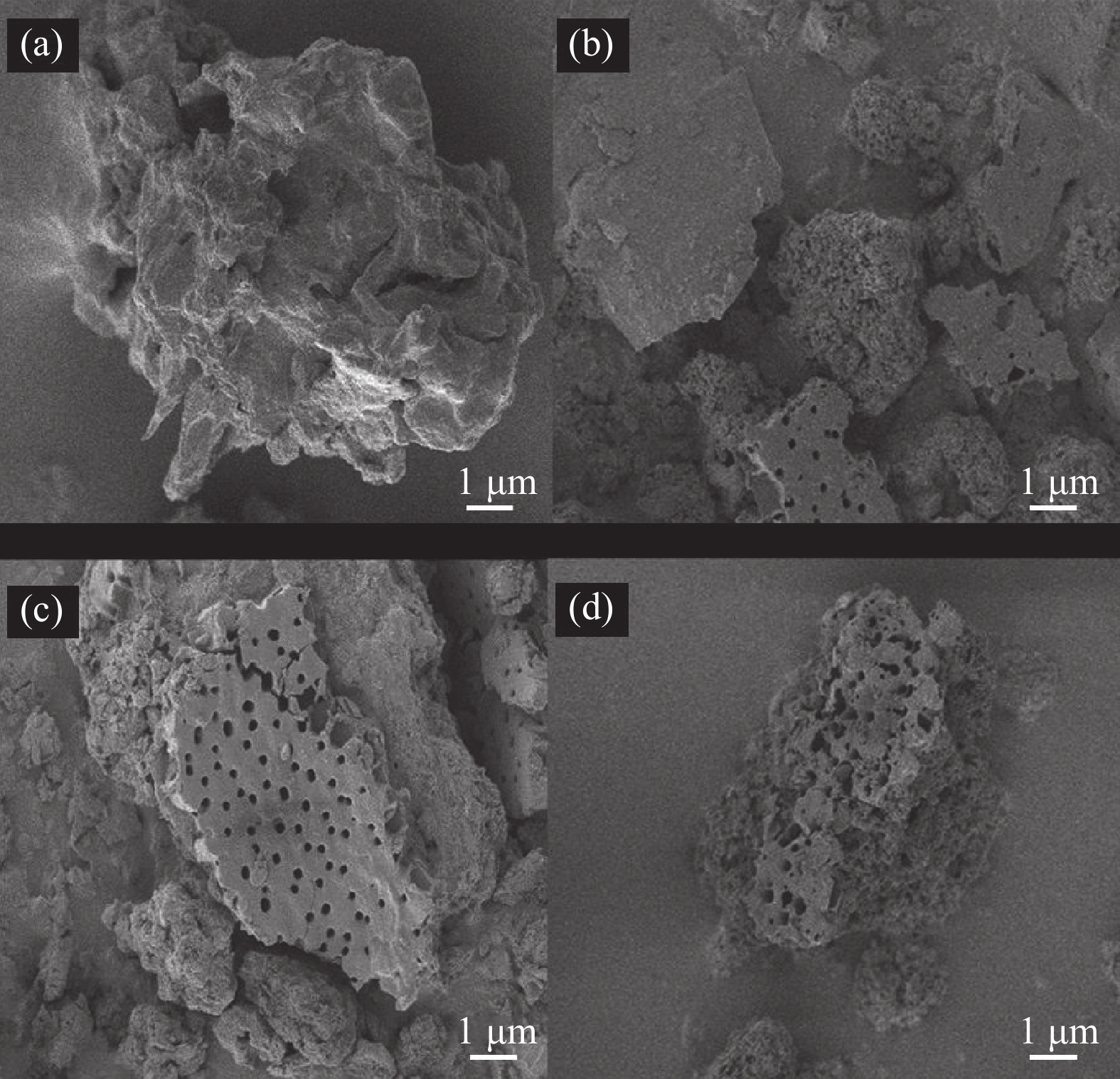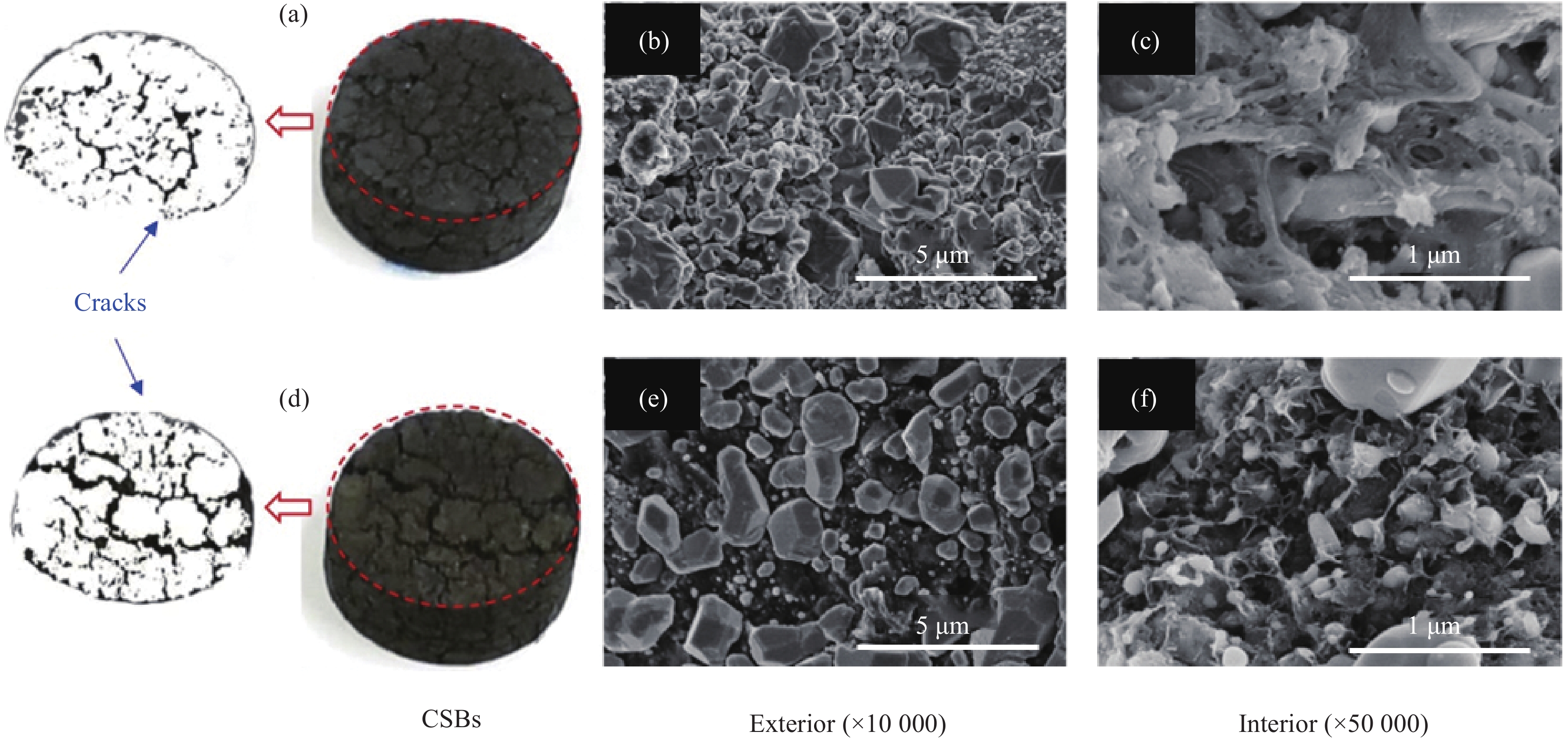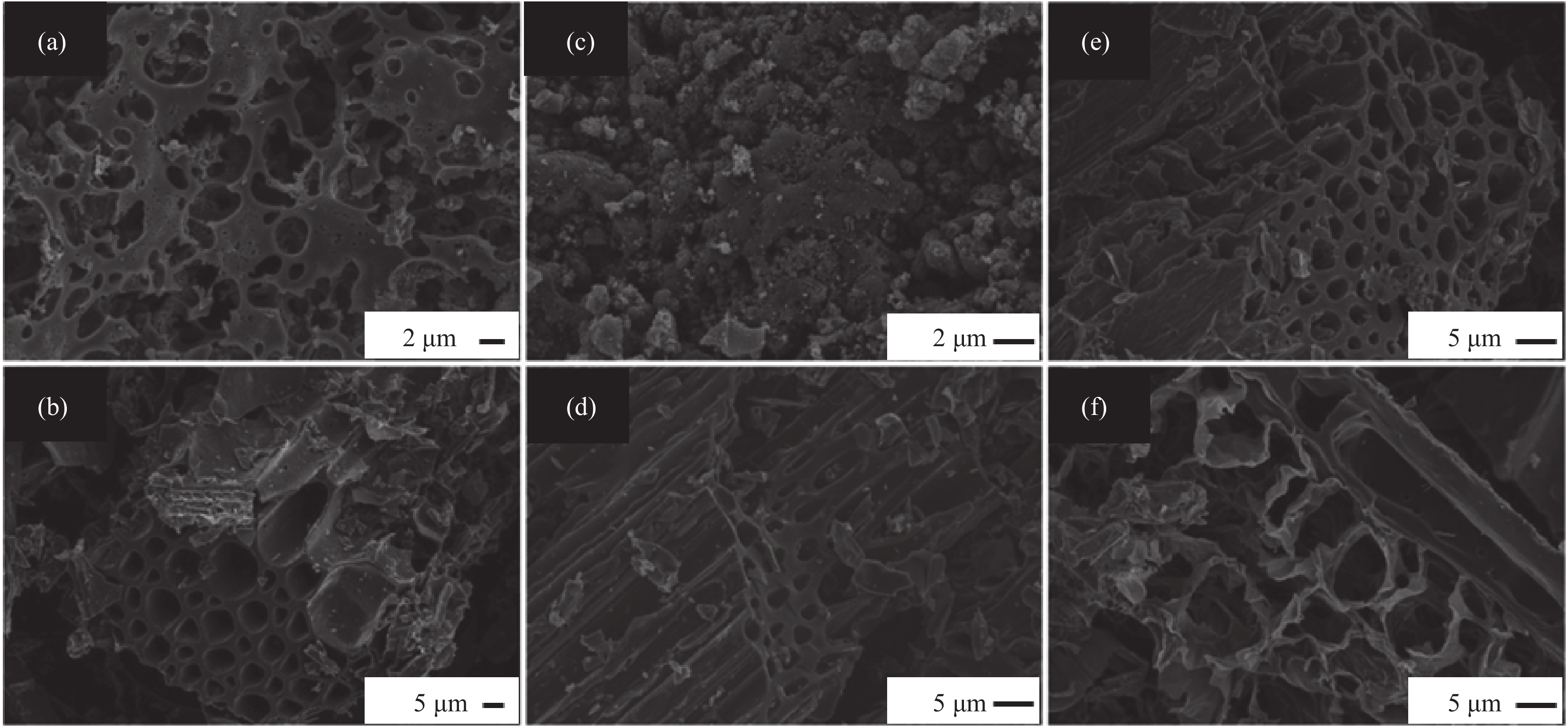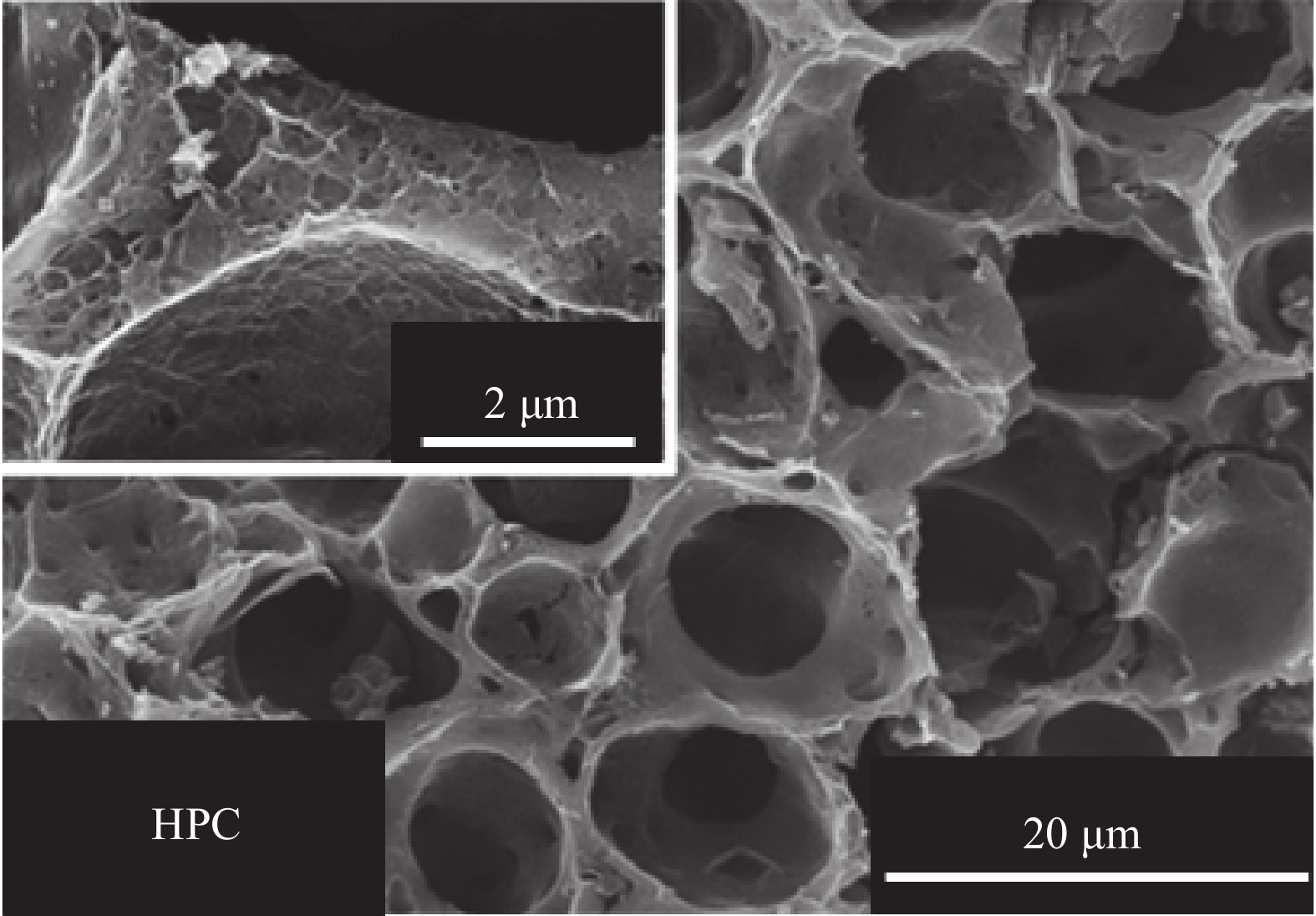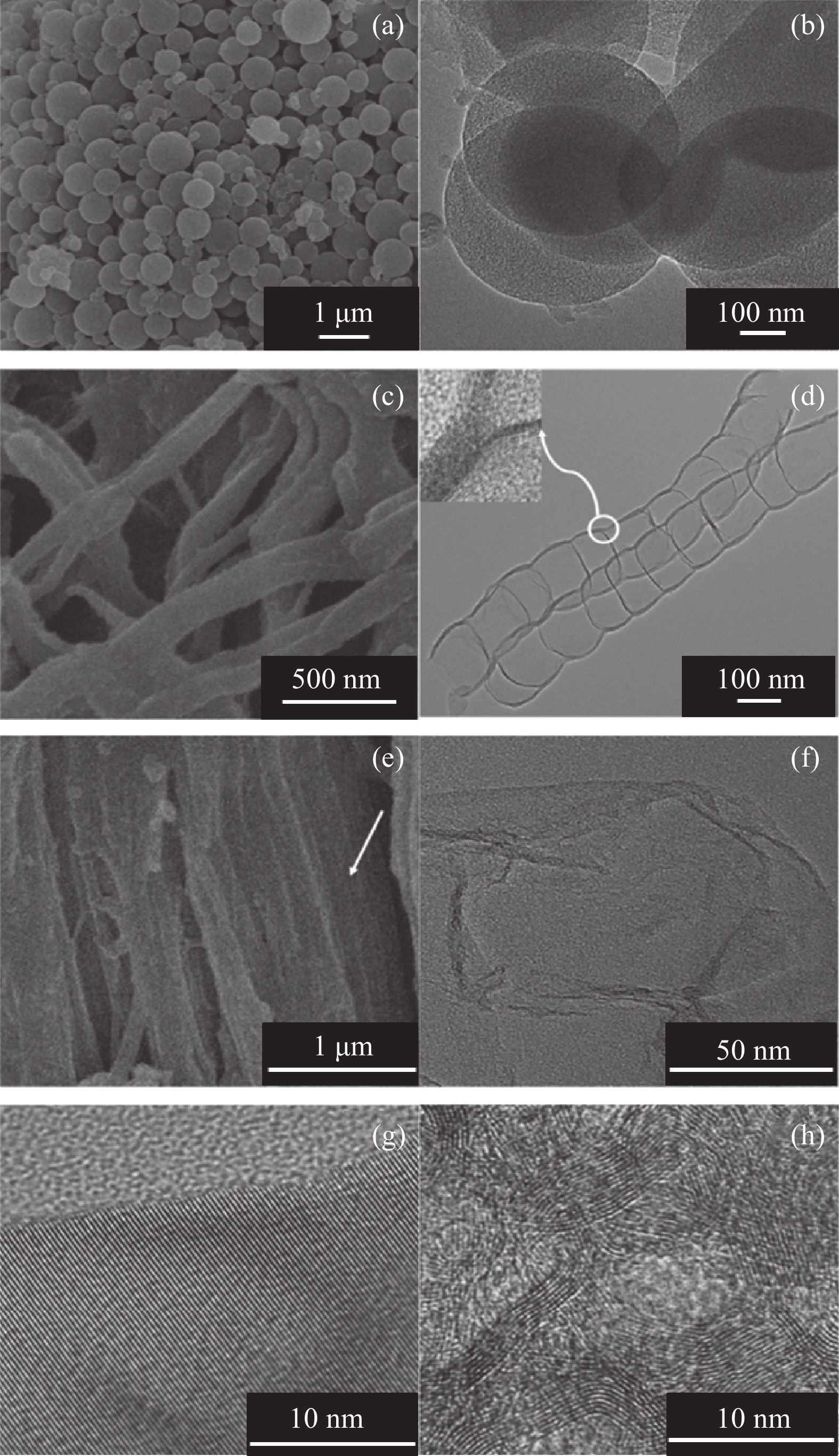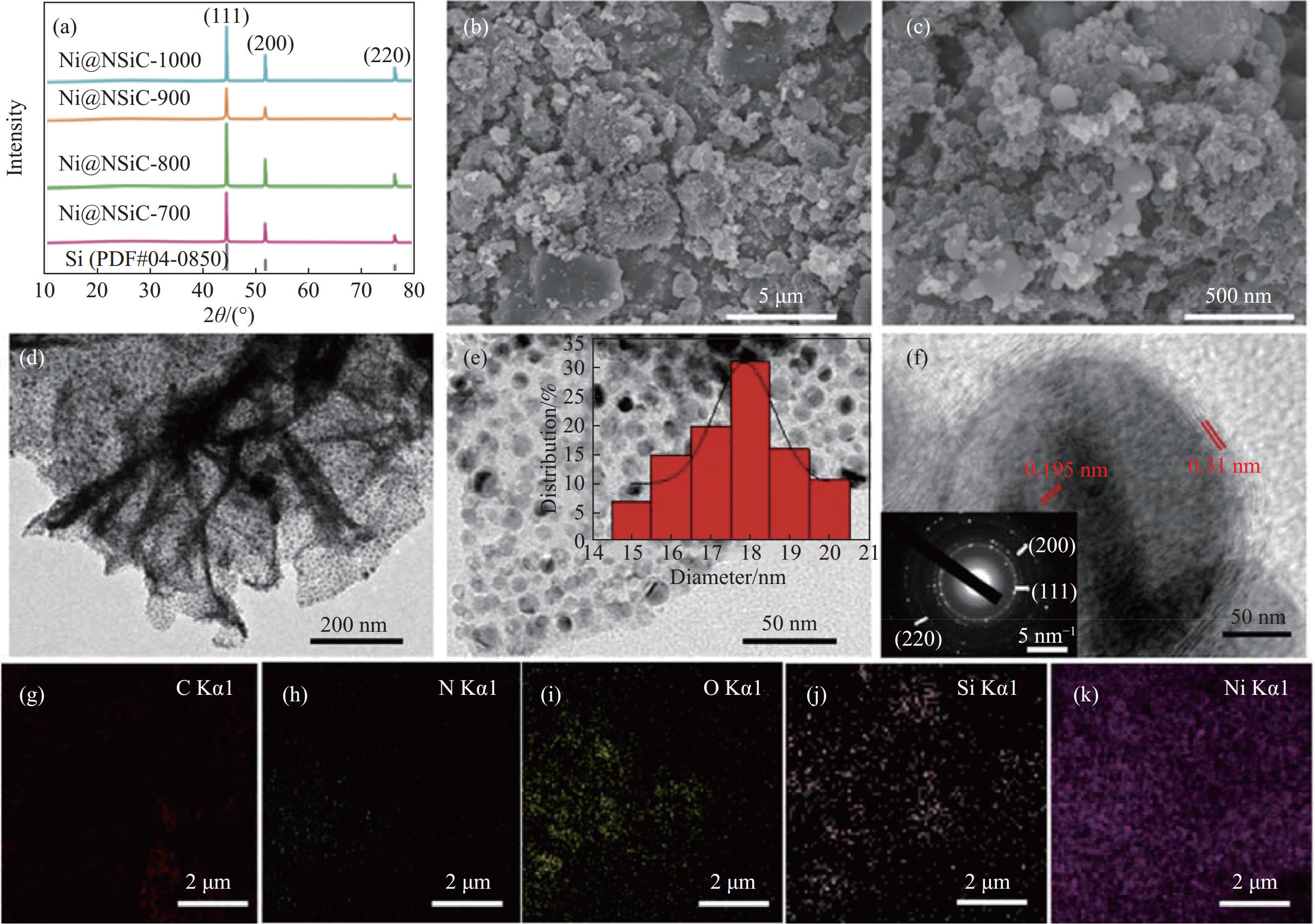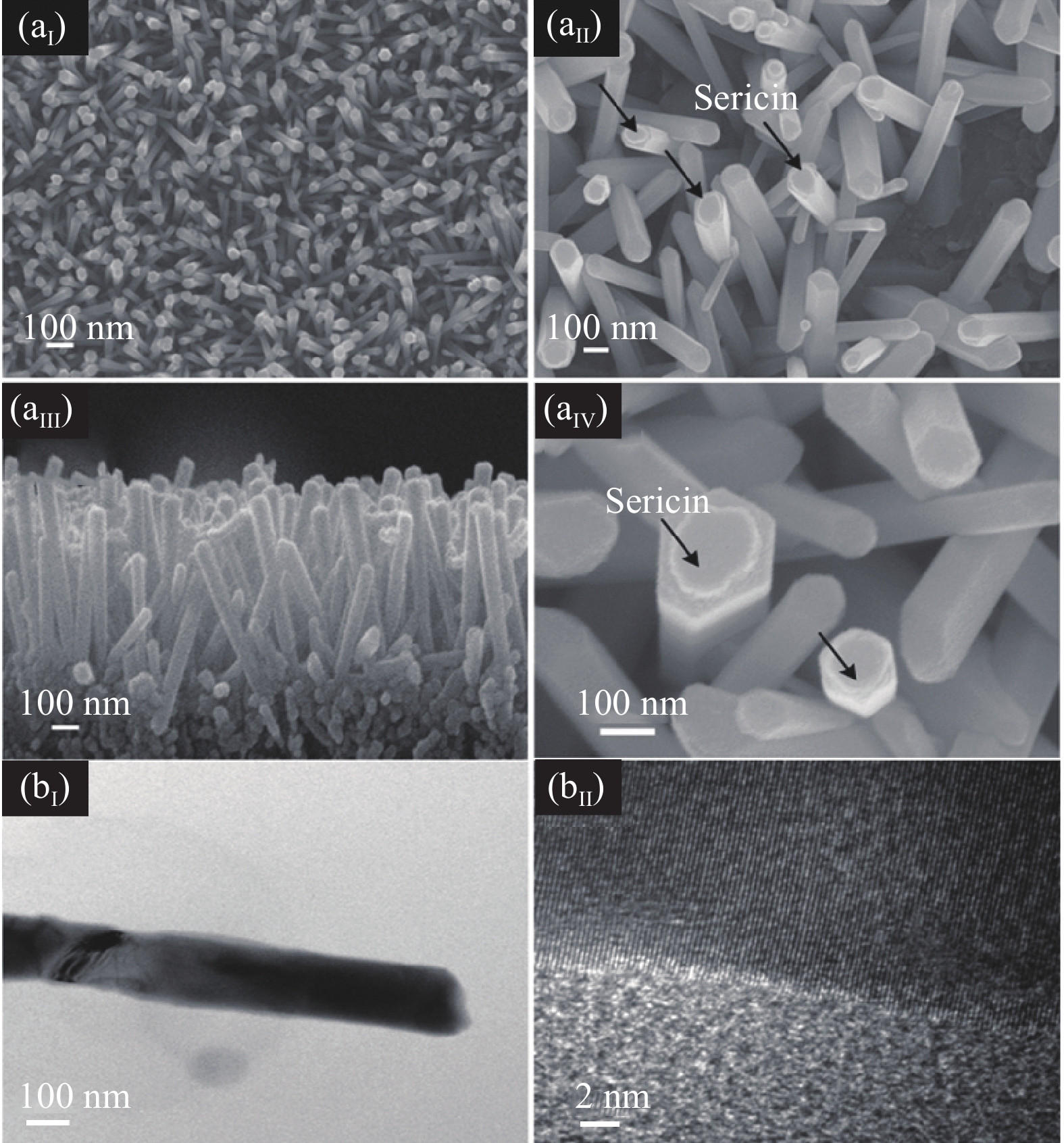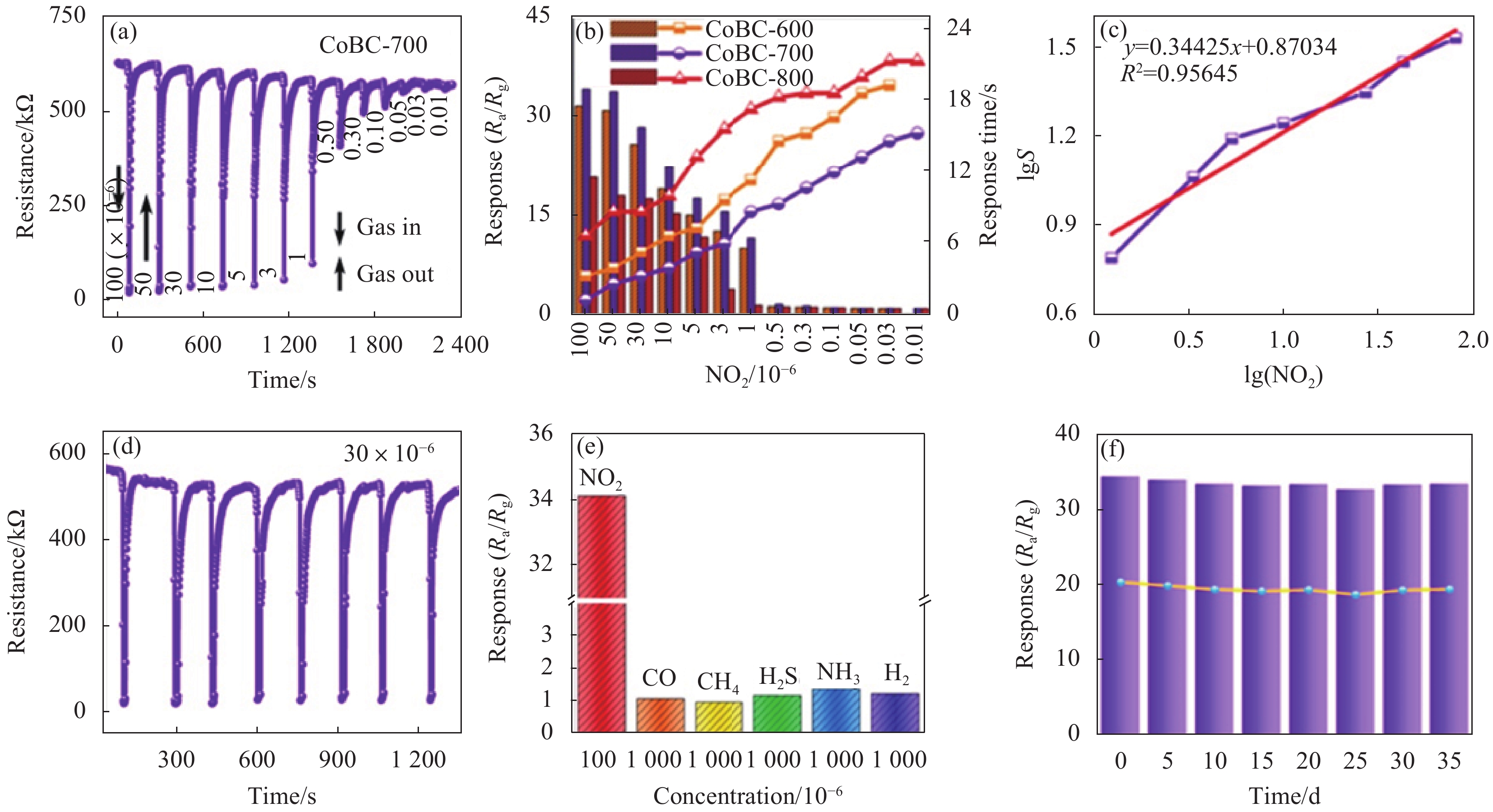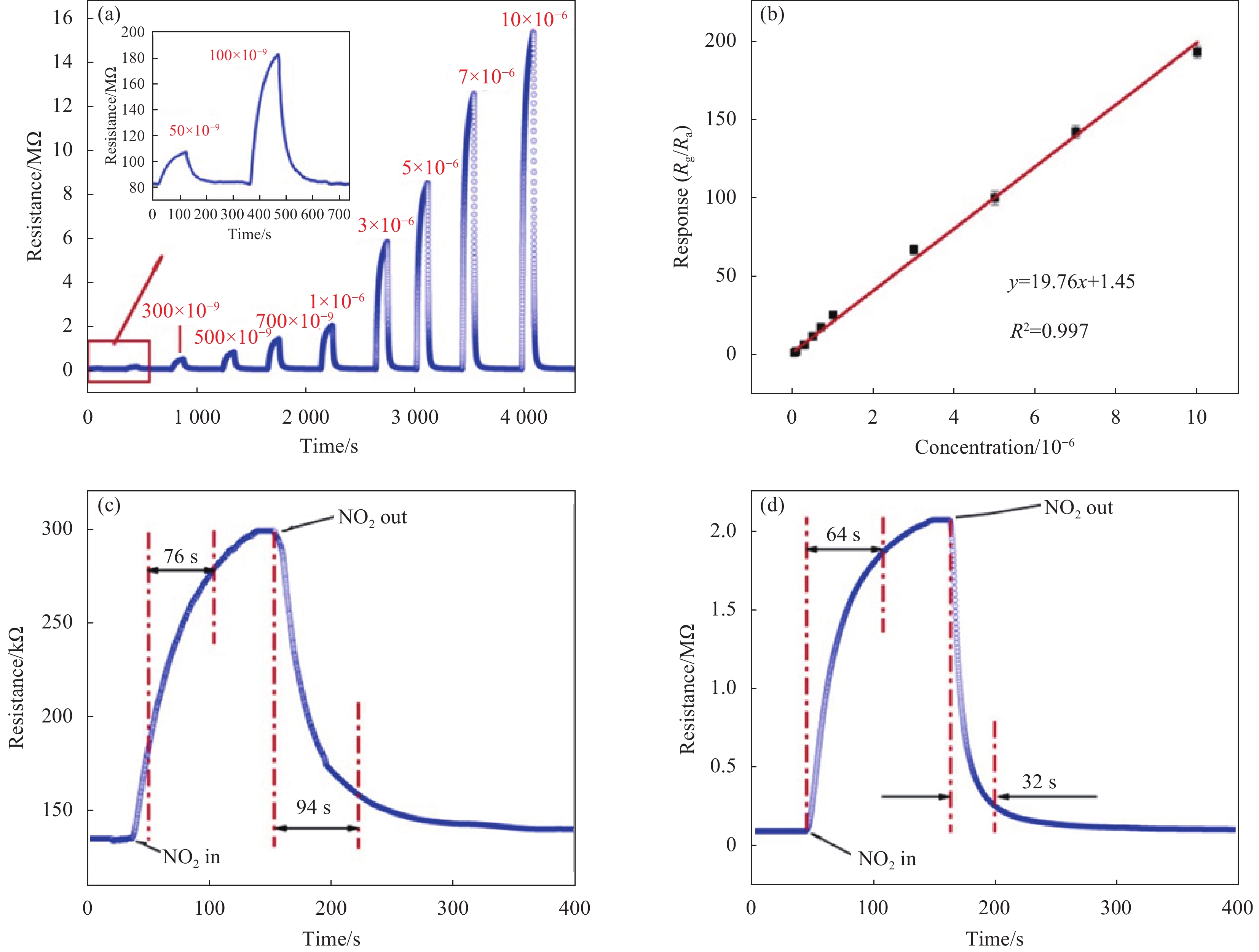Advances in the application of biomass charcoal materials for gas sensing detection
-
摘要:
随着全球能源需求的增长和环境问题的加剧,开发新型高性能气体传感器变得尤为迫切。生物质炭材料是由生物质原料经过预碳化和活化处理获得,具有独特的孔隙结构、大的比表面积、丰富的表面活性官能团和活性位点,在气体传感检测领域具有巨大的应用潜力。本文按照生物质炭的主要来源对生物质进行了分类(植物基、动物基和微生物基)以及4种生物质炭材料的常见制备方法(水热炭化法、活化法、模板法和微波热解法)。本文重点讨论了生物质炭材料在半导体型气体传感器和非金属氧化物主导型气体传感器的最新研究进展,包括作为气敏材料在检测各类气体方面的应用。最后,分析了生物质炭基气体传感器目前需要解决的问题,为拓宽该类传感器的实际应用提出了研发的思路。
Abstract:The development of new high-performance gas sensors has become particularly urgent with the growth of global energy demand and the aggravation of environmental problems. Biomass char materials are obtained from biomass raw materials through pre-carbonization and activation treatment, which have unique pore structure, large specific surface area, abundant surface active functional groups and active sites, and have great potential for application in the field of gas sensing and detection. In this paper, biomass is classified according to the main sources of biomass char (plant-based, animal-based, and microbial-based) as well as four common preparation methods of biomass char materials (hydrothermal carbonization, activation, templating, and microwave pyrolysis). The paper focuses on the recent research progress of biomass char materials in semiconductor-based gas sensors and non-metallic oxide dominated gas sensors, including their applications as gas-sensitive materials for the detection of various types of gases. Finally, the current problems that need to be solved for biochar-based gas sensors are analyzed, and ideas for research and development are proposed to broaden the practical applications of such sensors.
-
Keywords:
- biomass /
- carbon material /
- sensor /
- gas sensing /
- semiconductor /
- non-metallic oxide
-
随着混凝土在工程建设领域中的广泛应用,其抗拉强度低、容易产生裂缝等缺点逐渐显露,严重影响工程结构的安全性和耐久性;与此同时,混凝土结构在实际工程中难免会遭受高温或火灾等恶劣情况,其强度和耐久性会受到很大的影响,而传统的养护方法难以从根本上对混凝土进行深层次的养护。21世纪初,国外学者首次提出在混凝土中引入高吸水性树脂(Super absorbent polymer,SAP)作为内养护材料,其具有保水性能优良、安全环保、成本低等诸多优点。
关于SAP的自身特性,不同研究者进行了相关试验研究。马邦耀[1]和李兆丰等[2]测试了相关种类SAP的性能指标,发现合成系高吸水性树脂具有优良的吸水性能和简易的生产工艺。Kang等[3]和申爱琴等[4]发现较小粒径的SAP释水后残余孔隙更小,水化反应产物能填充孔隙并增强界面过渡区的黏结强度。Jensen和Hansen[5-6]的研究表明,SAP颗粒粒径为100 μm时吸水率较高,内养护效果更好。此外,SAP的吸水能力也依赖于所吸收液体种类影响,其在水泥浆液中的吸水倍率远低于在纯水中的吸水倍率[6-9]。这对混凝土内养护水的提供有重要影响。
国内外很多研究者针对SAP内养护混凝土的强度及耐久性能进行了相关研究。Yao等[10]认为在工程水泥基复合材料(ECC)中加入SAP会提高后期强度和韧性,其中拉伸应变能力可提高92%;丁以兵等[11]认为SAP能大幅提高混凝土的抗冻融性与抗渗透性,且SAP在干热条件下对于耐久性的提高更为有利;Senff等[12]、Esteves等[13]、Klemm等[14]、Nestle等[15]、Qin等[16]和Yang等[17]研究发现SAP对水化程度的控制和提升作用可有效提高混凝土的后期强度。但同时SAP颗粒的掺入对混凝土的力学性能具有一定的削弱。李曈等[18]通过试验研究发现,随着SAP掺量的增加,玄武岩纤维混凝土的抗压、抗拉和抗折强度先增大后减小,当SAP掺量为0.3vol%时,抗拉、抗折强度分别下降了6.12%、12.03%;Xie等[19]在对SAP内养护混凝土力学性能研究发现,内养护水的引入和SAP 失水干缩后留下的孔隙对混凝土抗拉强度具有削弱作用;Hasholt等[20]指出内部固化的加水量过大时,SAP的吸水率会过高,造成混凝土强度的损失。
为弥补 SAP 高吸水率对混凝土强度的负面影响,在混凝土中加入纤维复合材料已成为提高混凝土性能的一种有效手段。工程中常用于增强混凝土的纤维材料主要有聚乙烯醇纤维(Polyvinyl alcohol,PVA)、聚丙烯纤维(Polypropylene,PP)、碳纤维(Carbon fiber,CF)、钢纤维、玄武岩纤维(Basalt fiber,BF)等,其中PVA纤维抗拉强度较高,物理和化学性能较钢纤维更稳定,且自重轻、生产成本低,是目前用于改善混凝土脆性和实际工程应用的主要材料之一。在混凝土中随机分布的PVA纤维与SAP有较好的协同作用,通过纤维桥联限制基体间裂缝的扩展,起到了较好的增韧、阻裂作用,使结构具有更好的抗弯拉、抗冲击、防爆裂等性能[21-24],从而提高混凝土的耐火性;此外PVA 纤维对高温作用后混凝土的劈拉强度改善作用较好,对断裂能具有增强效应[25]。因此PVA 纤维是一种较好的提升混凝土抗裂性与韧性的纤维材料。沈才华等[26]研究发现,混凝土的峰值强度和抗折强度随着PVA纤维掺量的增大先增大后减小,建议最佳纤维掺量为0.2vol%。蒋津等[27]研究了PVA纤维对卵石混凝土的影响,试验结果表明PVA纤维会降低混凝土的抗压强度、弹性模量和泊松比,且降低幅度随着混凝土水灰比的减小而增大,却有效提升了抗拉强度和韧性。白文琦等[28]认为200℃为混凝土力学性能发生改变的转折点,PVA纤维在温度低于200℃时对抗压强度影响不大,能够较好改善抗折强度和韧性。蒋玉川[25]对PVA纤维混凝土进行高温后残余力学性能试验,试验结果表明随着PVA纤维掺量的提高,纤维对残余抗拉强度和断裂能的提升幅度有限,但能够提高高性能混凝土的抗火性能,建议纤维的适宜体积掺量为0.05vol%~0.2vol%。
目前,国内外学者在SAP和PVA纤维单独作用对混凝土性能影响方面已有大量研究,但缺乏混凝土复掺SAP和PVA纤维二者协同作用的结果与结论。与此同时,在前述SAP-PVA纤维混凝土损伤本构模型研究[29]中尚未探讨SAP内养护PVA纤维混凝土在不同温度下的轴拉软化特性;纤维掺量、温度对试件轴拉断裂方式、断裂能,以及内在断裂机制的影响尚不明确。
基于上述研究背景,本文开展了单轴状态下SAP内养护PVA纤维混凝土拉伸试验,分析了其在不同温度以及纤维掺量下应力-位移曲线的变化规律及软化特性,深入研究不同条件下纤维混凝土断裂能以及内在断裂机制,探讨了PVA纤维和SAP协同作用对混凝土的增韧阻裂机制,研究结果可为SAP内养护PVA纤维混凝土的工程应用和后期损伤检测等领域提供理论参考。
1. 试 验
1.1 试件准备
试件所用材料与前述研究者一致[30],水泥采用P·O 42.5级普通硅酸盐水泥,采用天然河砂作为细骨料,属中砂,平均粒径为0.35~0.5 mm,细度模数为2.3~3.0,拌和水采用自来水,粗骨料采用粒径为5~20 mm的玄武岩碎石;采用复合型聚羧酸高性能减水剂以增强混凝土的工作性能。纤维采用上海臣启化工科技有限公司生产的高强高弹模聚乙烯醇(PVA)纤维;结合前述研究,为达到更好的内养护效果,本文采用江苏省宜兴市可信化工有限公司生产的高吸水率、平均粒径为100 μm的合成系 SAP 聚丙烯酸钠颗粒进行试验[29]。
为分析PVA纤维掺量对混凝土轴拉力学性能的影响,本文采用体积分数为0vol%、0.05vol%、0.1vol%、0.15vol%和0.2vol%的PVA纤维掺量,而SAP最佳内养护引水量的理论计算方法则根据Powers模型[31-32]确定。混凝土配合比如表1所示。
表 1 混凝土试件组分配合比(kg/m3)Table 1. Mix proportions of concrete specimens (kg/m3)Item Water Cement Sand Coarse aggregate Water reducer SAP PVA Water-cement ratio Internal conservation
water qualityC 155 480 640 1160 1.2 0.000 0.000 0.323 0.0 0.05%PVA/C 155 480 640 1160 1.2 1.116 0.645 0.323 27.9 0.10%PVA/C 155 480 640 1160 1.2 1.116 1.290 0.323 27.9 0.15%PVA/C 155 480 640 1160 1.2 1.116 1.935 0.323 27.9 0.20%PVA/C 155 480 640 1160 1.2 1.116 2.580 0.323 27.9 Notes: In the specimens of polyvinyl alcohol (PVA) fiber concrete cured in super absorbent polymer (SAP), a%PVA/C—PVA fiber volume fraction admixture of specimen is avol%. The dosage of SAP of item C is 0, other items are 1.116 kg/m3. 1.2 试件制备
试验采用干掺法(额外引水)进行SAP颗粒的掺入。混凝土拌合物采用建新机械JS750双卧轴强制式搅拌机进行搅拌,搅拌过程中均匀撒入PVA纤维至设计用量,随后倒入相应模具中进行机械振捣密实并抹平。共浇筑5批不同PVA纤维含量的混凝土试件。放于室内进行翻盖养护,24 h后脱模并放入标准养护室内养护28 d。试验前将混凝土切割成直径为72 mm、高度为144 mm的圆柱体,然后进行相应的力学性能试验。
1.3 试验方法
轴拉试验采用MTS工业系统公司所产的MTS 322型电液伺服万能试验机。试件采用强度为10 MPa的环氧树脂胶粘结在钢板上。由于环氧树脂胶的强度远超混凝土抗拉强度,因此不会在粘结处破坏。为保证轴拉试验不出现偏拉现象,采用特制的球头连接加载钢板和试验机作动头[33-34]。为获得试件加载的下降段,加载控制方式采用位移控制,加载速率设置为3.5×10−4 mm/s。
采用洛阳市博莱曼特试验电炉有限公司生产的BLMT-1800B型高温节箱立式箱式炉对混凝土试件进行加热,设计了常温(25℃)、200℃、300℃、400℃等4个温度梯度[29]。升温速率为5℃/min,待试件加热到指定温度并恒温保持150 min后再将试件自然冷却至室温[35],如图1所示。试验前将混凝土试件的编号统一命名为:a%PVA/C-b-c(素混凝土编号用C来替代a%PVA/C),其中a表示试件所含PVA纤维的体积百分比掺量,b表示加载过程时的测试温度,c表示该温度下的试件编号(1~3)。
2. 实验结果与分析
2.1 SAP内养护PVA/C轴拉破坏模式
在较低速率的位移控制下,由于混凝土的轴拉脆性较强,轴拉试验中试件在发出“嘭”的一声后瞬间断裂。图2为混凝土试件在高温下的典型破坏模式,从图中可以观察到,混凝土试件在拉应力作用下产生横向裂缝直至完全破坏且断裂位置沿混凝土试件轴向随机分布,钢板和试件的接触面处并没有发生破坏。根据最小耗能原理[36],试件的破坏总是以单位时间内能量消耗最小的方式进行,故混凝土中裂纹扩展为绕过强度较高的骨料并直接穿过骨料与砂浆的界面产生破坏;而当温度较高时,试件内部已形成一定范围的微裂缝,最小耗能效应就更为明显。
从图3(a)可以发现,裂缝主要发生在骨料和水泥砂浆的界面过渡区处,此区域存在着大量的微裂纹和微孔洞。常温下,混凝土受拉达到峰值应力,基体的薄弱区域开始出现离散微裂缝,但其扩展受到纤维桥联作用的限制。随着荷载的继续增大,试样内部的离散微裂缝逐渐连接形成宏观的连续裂缝,部分纤维在拉力作用下屈服或与基体发生黏结滑移。当达到失效荷载时,断裂面上的纤维基本断裂或被拉出,混凝土试样完全破坏。如图3(b)所示,在高温作用下,混凝土试件内部水分蒸发加剧,断裂处逐渐变为灰白色,由于高温造成内部微裂纹的增多使得断裂面处更加平整。
为了更深入地了解混凝土试件微观断裂面形貌以及SAP与PVA纤维的协同作用对试件内在断裂机制的影响,对混凝土断裂面进行了扫描电镜分析(SEM)。图3(c)为500 μm尺度下常温纤维混凝土试件微观断裂面形态。可以看到,基体界面整体上较为饱满。SAP颗粒经过释水形成的孔洞较少,PVA纤维与胶凝团黏结较为紧密,多为断裂破坏形态。
以SAP与PVA协同作用的角度来解释,常温条件下混凝土基体内的SAP颗粒遇水时会迅速吸水,形成类似“蓄水库”的内部结构。当水泥水化反应耗水而环境湿度差异较大时,SAP颗粒会将预吸收的水分缓慢释放,延缓基体内部相对湿度的降低,提高了胶凝材料的水化程度和基体密度,从而增强了混凝土基体与PVA纤维之间的黏结强度,并促进了纤维的桥联作用;同时PVA纤维具有较高的抗拉强度和弹性模量,与胶结基体具有良好的亲和性和黏结性。这种协同作用显著抑制了混凝土基体薄弱区域的开裂与扩展,提高了试件的韧性与抗裂性能。
图3(d)为500 μm尺度高温下混凝土试件微观断裂面形态。当温度升高时,基体水分蒸发加剧,形成的微裂缝与孔洞数量明显增多,并伴有局部的碎裂和剥落。从图中可以看出PVA纤维多为拉伸屈服、黏结滑移失效,这说明SAP颗粒失水蒸发造成胶凝团与PVA纤维的黏结劣化。当温度超过200℃时,内部的 PVA 纤维熔化形成疏松的孔隙,纤维桥联作用失效,无法抑制基体内裂纹的扩展与破坏。
2.2 SAP内养护PVA/C轴拉应力-位移曲线
根据MTS试验机单调加载测得的数据,不同温度及纤维掺量下试件应力-位移曲线如图4所示。
图4(a)显示,常温条件下,随着纤维掺量的提高,混凝土的轴拉强度有比较明显的提升,但峰后残余应力的变化并不明显;图4(b)表明随着温度的升高,轴拉峰值荷载出现显著降低,峰值段平台区增大,峰后软化段更加平缓,应力下降速度变慢。这可能是由于高温造成混凝土内部微裂纹等缺陷增多,断裂过程区应力传递变缓。
2.3 SAP内养护PVA/C的轴拉力学特性
Chan等[37]通过试验研究发现,高温后混凝土的孔径分布和孔隙度变化很大,造成混凝土强度与密实度的降低。为了深入分析SAP内养护PVA纤维混凝土的单轴拉伸力学性能,绘制平均峰值应变、平均峰值应力比和平均初始弹性模量这3个参数随温度的变化曲线,如图5(a)~5(c)所示。
抗拉强度是反映混凝土拉伸性能的关键参数,引入高温下拉伸试件峰值应力与25℃下峰值应力之比来分析温度对PVA纤维混凝土拉伸强度的影响。从图5(a)可以看出,试样整体的峰值应力比随温度的升高而不断降低,峰值应力比在200℃以下以相对较低的速率下降,此时混凝土中水分蒸发较少,水化产物分解较缓慢;而超过200℃后混凝土中水化产物分解加快,SAP颗粒与PVA纤维部分开始融化,混凝土整体强度降低,峰值应力比下降速率加快。混凝土试件在200℃时的整体抗拉强度为25℃的80%左右,而到400℃时抗拉强度基本丧失,抗拉强度仅为正常温度下的40%。这也与EN规范中高温对混凝土抗拉强度的影响趋势相吻合[38]。
图5(b)显示混凝土弹性模量的变化趋势随温度的升高不断降低,且下降速率逐渐减缓。在25~300℃之间不同纤维掺量试样的弹性模量降低速率明显高于300~400℃之间的降低速率。以试件0.05vol%PVA/C为例,在经历200℃、300℃和400℃后,其弹性模量依次降低为常温时弹性模量的53.7%、29.8%、27.9%。这是由于高温导致混凝土内部结构松散,混凝土抵抗变形能力劣化。
抗拉峰值应变是反映混凝土变形的关键指标。从图5(c)可以看出随着温度的升高,混凝土试件的峰值应变不断增大。其中,温度在25~200℃时,峰值应变的上升速度比较缓慢,此时高温对混凝土的损害小,试件内部仍较为紧密,PVA纤维掺入对混凝土有较好的增韧效果;而温度超过200℃后,混凝土在高温下的损伤加剧,导致峰值应变上升显著加快,表明高温对混凝土延性的增加。
2.4 SAP内养护PVA/C软化本构模型
2.4.1 断裂能定义
混凝土类材料从微观损伤发展到宏观破碎实际上是一个能量消耗的过程。在这一过程中可以把试件破碎视为能量消耗的直接原因,因此从能量角度分析可以更全面地解释试件破坏过程,减小由于材料不均匀性对结果造成的影响,以达到较好的定量分析效果。
断裂能作为解释混凝土试件断裂过程中消耗能量的一种方法,指的是在单位裂纹表面上耗散的总能量,即混凝土在出现宏观裂缝后轴向应力-裂缝张口曲线下方的面积[39],如图6所示。
![]() 图 6 裂缝张开位移计算图Figure 6. Calculation diagram of crack opening displacementδ0—Residual deformation corresponding to the peak point of the stress-displacement curve (i.e., no recoverable deformation); w—Crack opening displacement; δe—Elastic change at any point on the stress-displacement curve deformation of an arbitrary point on the stress-displacement curve; δt—Peak point displacement on the axial stress-displacement curve; σt—Peak point stress corresponding to peak point displacement; Et—Modulus of elasticity
图 6 裂缝张开位移计算图Figure 6. Calculation diagram of crack opening displacementδ0—Residual deformation corresponding to the peak point of the stress-displacement curve (i.e., no recoverable deformation); w—Crack opening displacement; δe—Elastic change at any point on the stress-displacement curve deformation of an arbitrary point on the stress-displacement curve; δt—Peak point displacement on the axial stress-displacement curve; σt—Peak point stress corresponding to peak point displacement; Et—Modulus of elasticity在轴拉试验中,内部张力薄弱区域微裂缝的形成及宏观连续裂缝的扩展都反映了混凝土随荷载作用而呈现出的软化现象,即试件变形增大而荷载减小。根据Hillerborg等[40]建立的虚拟裂纹模型(FCM)和Bazant[41]建立的裂缝段断裂模型(CBM),曲线下降段中的变形是由应变和裂纹开口形成的。因此,本文考虑应变和裂纹开口来描述混凝土在单调轴拉下的峰值后应力-位移关系。
在分析和计算曲线软化段时,首先要对裂缝张开位移w进行分解,计算公式如下[42]:
δ=δe+δ0+w (1) 式中:δ 为试件在轴向应力上通过引伸计测量得到的总位移值;δe 为应力-位移曲线上任意点的弹性变形;δ0 为应力-位移曲线峰值点对应的残余变形(即不可恢复的变形);w为裂缝张开位移,如图6所示。
式(1)中的δe 和 δ0 可采用下式进行计算:
δe=σEtl (2) δ0=δt−σtEtl (3) 式中:σ为应力;Et为弹性模量;δt为轴向应力-位移曲线上的峰值点位移;σt为峰值点位移所对应的峰值点应力;l为试件的长度。
假设在δ0之前没有裂缝,则混凝土试件的裂纹宽度可以写为
w=δ−δe−δ0 (4) 由于断裂能等于轴向应力-裂缝宽度曲线下的面积,然而在试验中难以将荷载卸载至应力为0状态,此外,试件多裂纹断裂也会导致对断裂能的高估。目前,国内外诸多学者均采用从试验中直接取值的方法[39, 42-43],因此得到的断裂能与实际的断裂能误差较大,本文采用Hordijk[44]提出的计算方法,将软化段曲线沿最大裂缝宽度值对应应力的切线方向延长,直至与横坐标轴相交,进而得到虚拟宽度w0,如图7所示,能降低断裂能计算的误差。因此,断裂能的计算方式为
GF=w0∫0σ(w)dw (5) 式中:GF为断裂能(N/mm);w0为极限裂缝宽度(mm)。
脆性通常指的是材料在发生明显的不可逆变形发展之前突然断裂的趋势。描述材料脆性的一个常用参数是特征长度Lch,其值越小,表明材料脆性越大。根据Hillerborg等[40]的研究,特征长度的计算公式如下所示:
Lch=EtGFft2 (6) 式中:Lch为特征长度(mm);ft为抗拉强度(MPa)。
2.4.2 软化段模型
根据试验获得的荷载-位移曲线,采用式(2)~(4)进行计算,则可以得到混凝土试件的轴向应力-裂缝宽度曲线,如图8所示。
为确定适合不同温度下内养护纤维混凝土试件的最佳轴拉软化段曲线,分别采用Hordijk[44]和Li等[42]提出的混凝土轴向应力-裂缝宽度的理论模型进行计算和对比,计算方式如下:
Hordijk模型[44]
σn=[1+(c1wwc)3]exp(−c2wwc)−wwc(1+c13)exp(−c2) (8) 式中:σn为归一化应力,即峰后应力与峰值应力的比值;c1和c2为拟合参数,随着温度的变化而变化;wc为临界裂缝长度。
Hordijk还提出了基于断裂能的临界裂缝长度计算公式,计算方式为
wc=5.14GFft (9) Li模型[42]
σ=ft{1−exp[−(k/ww0)n]} (10) 式中:k和n为拟合参数;w0为最大裂缝宽度。
2.4.3 断裂能、特征长度和临界裂缝长度
根据试验曲线,式(5)、式(6)和式(8)可求得不同温度下混凝土试件断裂能、特征长度和临界裂缝长度平均值,如表2和图9所示。
表 2 不同温度与纤维掺量下SAP内养护PVA纤维混凝土断裂能、特征长度和临界裂缝长度平均值Table 2. Average values of fracture energy, characteristic length and critical crack length of PVA fiber concrete cured in SAP with different temperatures and fiber dosagesItem Fracture
energy
GF/(N·mm−1)Characteristic
length
Lch/mmCritical
crack length
wc/mmC-25℃ 0.287 1341.945 0.535 C-200℃ 0.251 1328.076 0.650 C-300℃ 0.242 1245.240 0.720 C-400℃ 0.226 1355.680 0.826 0.05%PVA/C-25℃ 0.341 2110.220 0.731 0.05%PVA/C-200℃ 0.290 1687.029 0.908 0.05%PVA/C-300℃ 0.249 1698.376 0.960 0.05%PVA/C-400℃ 0.225 1990.315 1.077 0.10%PVA/C-25℃ 0.310 1762.373 0.639 0.10%PVA/C-200℃ 0.251 1552.835 0.682 0.10%PVA/C-300℃ 0.212 1407.621 0.869 0.10%PVA/C-400℃ 0.167 1953.715 0.989 0.15%PVA/C-25℃ 0.297 1579.185 0.583 0.15%PVA/C-200℃ 0.248 1229.602 0.633 0.15%PVA/C-300℃ 0.206 1316.608 0.733 0.15%PVA/C-400℃ 0.163 1001.284 0.851 0.20%PVA/C-25℃ 0.295 1167.763 0.502 0.20%PVA/C-200℃ 0.243 1070.596 0.574 0.20%PVA/C-300℃ 0.198 970.560 0.639 0.20%PVA/C-400℃ 0.167 1845.660 0.785 从图9(a)可以看出,混凝土试件的断裂能随着温度的升高趋势不断降低,且降低速率增加。以0.05vol%PVA/C试件为例,其在不同高温下的断裂能相比于常温下分别降低了14.89%、27.01%、34.12%,这是热损伤对混凝土试件造成的直接影响。200℃前,随着纤维掺量的增大,试件的断裂能先增后降,这主要归因于PVA纤维的增韧和阻裂效果在常温和200℃时仍能发挥作用,它在试件断裂过程中吸收和消耗了部分能量,降低了试件的脆性。然而,过量的纤维会在混凝土基体内引入过多的缺陷,导致其力学性能下降,因此断裂能呈现出降低的趋势;高温下由于SAP颗粒和PVA纤维熔化形成的孔洞和通道反而会成为混凝土基体中的缺陷,造成纤维混凝土密实度与断裂能降低。总的来说,适量的PVA纤维的添加能够提高混凝土的断裂能,改善混凝土试件的抗裂性能和韧性。从断裂能量的角度来看,断裂能越大,意味着裂纹表面耗散的能量越多,内部微裂纹的扩展和演化程度也就越充分。
图9(b)显示了混凝土试件特征长度随温度及纤维掺量变化的趋势。相同温度下,试件的特征长度随纤维掺量提高先增后减,并在0.05vol%掺量下达到最大,这与断裂能变化趋势一致,表明一定量的纤维对混凝土变形能力及韧性的提升;在高温条件下,由于PVA纤维熔化形成裂缝使得混凝土基体的缺陷增多,试件抗拉强度的下降速率高于断裂能的下降速率,故表现为特征长度的反弹。
图9(c)中混凝土临界裂缝长度随纤维掺量的变化趋势与断裂能相似,且随着温度的升高逐渐增大,说明高温下SAP与PVA纤维熔化,混凝土孔洞增多,水化产物分解也会造成混凝土密实度降低,裂缝增大。
2.4.4 参数分析
采用式(7)和式(9)对软化段曲线进行拟合,拟合得到的参数c1、c2、k、n和拟合度R2的平均值如表3所示。
表 3 不同温度与纤维掺量下SAP内养护PVA纤维混凝土软化段模型参数平均值汇总表Table 3. Summary of the average values of softening segment model parameters of PVA fiber concrete cured in SAP at different temperatures and fiber dosagesItem Hordijk[44] model Li[42] model c1 c2 R2 k n R2 C-25℃ 3.048 6.967 0.999 0.0288 0.906 0.990 C-200℃ 4.125 8.429 0.998 0.0184 0.764 0.996 C-300℃ 3.797 6.590 0.983 0.0227 0.647 0.982 C-400℃ 4.209 7.020 0.987 0.0279 0.613 0.994 0.05%PVA/C-25℃ 3.700 7.447 0.983 0.0234 0.745 0.976 0.05%PVA/C-200℃ 4.326 7.086 0.990 0.0301 0.591 0.995 0.05%PVA/C-300℃ 4.758 7.955 0.992 0.0341 0.649 0.993 0.05%PVA/C-400℃ 3.655 5.698 0.990 0.0381 0.814 0.992 0.10%PVA/C-25℃ 4.970 9.000 0.990 0.0179 0.724 0.990 0.10%PVA/C-200℃ 4.291 8.533 0.990 0.0160 0.738 0.992 0.10%PVA/C-300℃ 2.678 2.608 0.996 0.0156 0.458 0.983 0.10%PVA/C-400℃ 4.360 5.950 0.998 0.0471 0.621 0.993 0.15%PVA/C-25℃ 4.988 9.639 0.997 0.0138 0.705 0.993 0.15%PVA/C-200℃ 3.530 7.170 0.996 0.0186 0.783 0.983 0.15%PVA/C-300℃ 2.812 7.064 0.997 0.0295 0.906 0.987 0.15%PVA/C-400℃ 1.728 5.391 0.978 0.0227 1.070 0.956 0.20%PVA/C-25℃ 6.203 10.890 0.959 0.0097 0.647 0.960 0.20%PVA/C-200℃ 3.060 6.766 0.994 0.0174 0.854 0.982 0.20%PVA/C-300℃ 4.330 8.557 0.981 0.0174 0.690 0.978 0.20%PVA/C-400℃ 3.367 5.520 0.998 0.0371 0.689 0.994 Notes: c1, c2—The fitted parameters of Hordijk[44] model; k, n—The fitted parameters of Li[42] model; R2—The degree of fitting. 田华轩等[43]在混凝土轴拉软化曲线及其尺寸效应研究中发现,式(7)中拟合参数c1、c2与试件的高径比和缝径比无定性影响,而随着试件直径的增大呈现减小趋势,表现出了明显的尺寸效应。根据本文模型拟合参数的变化规律来看,Hordijk[44]模型拟合参数c1、c2随着温度的变化表现出明显的下降趋势,如图10(a)和10(b)所示;在常温条件下,参数c1、c2拟合参数随着纤维掺量变化增大,而高温条件下则无明显规律。而式(9)中拟合参数k、n随着温度与纤维掺量的变化皆未表现出明显的规律,如图10(c)和10(d)所示。
这与田华轩等[43]在尺寸效应对混凝土轴拉软化段影响得出的规律近似。本文Hordijk[44]模型中参数c1和c2的平均值均随温度的增大不断减小,表明温度对混凝土试件峰后软化段具有定性影响;同时c1、c2关于纤维掺量的变化趋势表明在温度不高时PVA纤维的掺入对试件峰后软化段有一定的影响,而高温条件下纤维掺量的改变则对峰后软化段无定性影响。这说明温度仍是影响混凝土峰后软特性的主要因素。
根据拟合结果,建立参数c1和c2分别与归一化温度T'=T/400和常温条件下纤维掺量PVA (vol%)的关系表达式,如下列各式所示:
c1=−1.192T′+4.586,R2=0.946 (11) c2=−3.295T′+9.157,R2=0.992 (12) c1=15.196PVA+3.062,R2=0.934,T=25℃ (13) c2=20.078PVA+6.781,R2=0.971,T=25℃ (14) 以0.20%PVA/C混凝土试件为例,不同温度下两种模型的拟合结果与试验结果的比较如图11所示。
从图11可以看出,拟合得出的R2值均较高,表明试验曲线与理论模型曲线具有较好的一致性,且随着温度的升高,下降段模型曲线与试验曲线几乎完全重合,这表现出明显的温度软化效应;然而,对于25℃的混凝土试件而言,模型拟合效果相对较差,这可能是由于常温下混凝土尚未受到高温损伤,软化特性尚不明显。当基体内纤维掺量较少或分布不均时,试件在轴拉荷载作用下可能发生位移突变,这对断裂能、临界裂缝长度的计算和模型参数的拟合均会造成不利影响。
通过对比拟合参数的变化规律发现,相较于Li[42]提出的模型,Hordijk[44]模型R2值较高,能够更真实地反映出本试验SAP内养护PVA纤维混凝土在不同温度下表现出的温度效应,也准确地反映混凝土试件在轴拉荷载下的峰后软化特性,故推荐Hordijk[44]模型作为本文内养护纤维混凝土的软化本构模型。应该指出的是,本文获得的轴拉峰后软化本构模型仍具有一定的局限性,对于其他种类以及不同条件下的纤维混凝土仍有待进一步研究。
3. 结 论
进行了不同温度下高吸水性树脂(SAP)内养护聚乙烯醇(PVA)纤维混凝土试件的单轴拉伸力学强度试验,分析了其试件力学性能、破坏形态、应力-位移曲线、断裂能等变化规律,揭示了高温下混凝土的内在断裂机制;采用Li[42]和Hordijk[44]提出的软化段模型,对应力-裂缝宽度曲线进行了分析,可以获得以下结论:
(1)温度效应对SAP内养护PVA纤维混凝土内在断裂机制具有显著影响。高温作用下SAP失水蒸发,混凝土基体强度及PVA纤维桥联作用削弱直至失效,但混凝土延性增加。当温度超过200℃时,PVA纤维可能融化,加剧了基体的裂纹扩展与断裂;
(2)温度效应使得混凝土应力-位移曲线峰后段表现出明显的软化特性,而常温下PVA纤维掺入对试件峰后残余应力变化并不明显;
(3)混凝土试件的断裂能随着温度的升高总体不断减小;相同温度下试件的特征长度随纤维掺量先增后减,并在0.05vol%掺量下达到最大;混凝土临界裂缝长度随着温度的升高逐渐增大。高温作用下PVA纤维的融化会造成断裂能的降低;
(4)通过模型参数对比发现,相较于Li[42]模型,Hordijk[44]模型能够更好地描述常温与高温条件下SAP内养护PVA纤维混凝土内在机制变化对轴拉试验曲线软化特性的影响,拟合得出的软化段参数c1和c2均随温度的增大而不断减小,在常温下随纤维掺量的增大而增大,表明温度效应与PVA纤维对混凝土峰后软化段有定性影响。但本文获得的软化模型参数仍具有一定的局限性,对于其他种类以及不同条件下的纤维混凝土的适用性仍有待进一步研究。
-
图 3 活性炭的SEM图像:(a) KOH-K;(b) KOH-KB;(c) H3PO4-K;(d) H3PO4-KB;(e) MnO2/KOH-KB;(f) MnO2/H3PO4-KB
Figure 3. SEM images of the activated carbons: (a) KOH-K; (b) KOH-KB; (c) H3PO4-K; (d) H3PO4-KB; (e) MnO2/KOH-KB; (f) MnO2/H3PO4-KB
KOH-K, H3PO4-K—Direct KOH and H3PO4 activation; KOH-KB, H3PO4-KB—Indirect KOH and H3PO4 activation
图 5 CSs (a)、CSF (c)、CSI (e)的SEM图像;CSs (b)、CSF (d)的TEM图像;CSI (f)、CSF (g)和CSI (h)的高分辨率TEM图像
Figure 5. SEM images of CSs (a), CSF (c) and CSI (e); TEM images of CSs (b) and CSF (d); High-resolution TEM images of CSI (f), CSF (g) and CSI (h)
CSs—Carbon spheres with developed micropore structures were obtained without a template; CSF—A tubular structure containing mesopores with long-range order was obtained using polyethylene-polypropylene glycol (F127); CSI—Layered carbon containing micro-/mesopores with short- and long-range order was obtained using an ionic liquid
图 6 (a) Ni@NSiC的XRD图谱;NSiC (b)和Ni@NSiC-900 (c)的SEM图像;((d), (e)) Ni@NSiC-900的TEM图像;(f) Ni@NSiC-900的HR-TEM图像(插图为选区电子衍射图);((g)~(k)) Ni@NSiC-900的元素图谱结果
Figure 6. (a) XRD patterns of Ni@NSiC; SEM images of NSiC (b) and Ni@NSiC-900 (c); ((d), (e)) TEM images of Ni@NSiC-900; (f) HR-TEM image of Ni@NSiC-900 (Inset figure SAED pattern); ((g)-(k)) Elemental mapping results of Ni@NSiC-900
图 9 (a) Co3O4/生物质炭(CoBC)-700传感器在室温(RT)(相对湿度(RH) 25%)条件下对NO2的动态响应-恢复曲线和响应时间;(b) CoBC-600、CoBC-700和CoBC-800传感器对100×10−6~0.01×10−6 NO2的响应和响应时间(其中直方图为响应值,线性图为响应时间);(c) CoBC-700传感器对0.01×10−6~100×10−6 NO2的校准曲线;(d) CoBC-700传感器连续暴露于30×10−6 NO2 (7个周期)的重现性;(e) CoBC-700传感器对各种气体响应的选择性测试;(f) CoBC-700传感器在35 d内对100×10−6 NO2的稳定性测试
Figure 9. (a) Dynamic response-recovery curve and response time of the Co3O4/biomass carbon (CoBC)-700 sensor to NO2 at the room temperature (RT) (Relative humidity (RH) 25%); (b) Response and response time of CoBC-600, CoBC-700 and CoBC-800 sensors from 100×10−6 to 0.01×10−6 NO2 (Among them, the histogram is the response value, and the linear graph is the response time); (c) Calibration curves of CoBC-700 sensor to 0.01×10−6-100×10−6 NO2; (d) Reproducibility of CoBC-700 sensor continuously exposed to 30×10−6 NO2 (7 cycles); (e) Selective testing of the response of CoBC-700 sensor to various gases; (f) Stability test of CoBC-700 sensor to 100×10−6 NO2 within 35 d
R2—Goodness of fit; S—Sensitivity
图 10 (a) In2O3-600传感器在92℃下对不同浓度NO2气体的响应-恢复曲线;(b) In2O3-600传感器的响应与不同浓度NO2气体之间的关系;In2O3-600传感器对100×10−9 (c)和1×10−6 (d) NO2气体的动态响应-恢复曲线[87]
Figure 10. (a) Response-recovery curves of In2O3-600 sensor to different concentrations of NO2 gas at 92℃; (b) Relationship between responses of In2O3-600 sensor and different concentrations of NO2 gas; Dynamic response-recovery curves of In2O3-600 sensor to 100×10−9 (c) and 1×10−6 (d) NO2 gas[87]
表 1 不同原料生物质炭理化性质(平均值±同原料95%置信区间)[30]
Table 1 Physical and chemical properties of biochars derived from different feedstocks (mean±95% confidence interval)[30]
Raw material pH Total organic carbon/% Surface area/(m2·g−1) Ash/% Total N/% Total P/% Total K/% Wood 8.2±0.2 72.6±1.3 164.4±24.1 7.84±1.1 0.6±0.1 0.4±0.1 0.7±0.2 Crop residue 9.5±0.2 61.1±1.6 109.2±1.7 23.60±1.7 1.3±0.1 0.7±0.1 3.3±0.5 Grass 8.7±0.3 63.9±1.8 63.4±2.3 17.90±2.3 1.2±0.1 0.4±0.1 1.7±0.4 Manure 9.4±0.2 45.6±2.7 36.6±3.1 38.82±3.1 2.5±0.2 2.4±0.4 3.2±0.4 Sludge 8.7±0.5 25.1±2.7 28.2±4.3 63.30±4.3 2.5±0.3 3.0±0.7 1.1±0.3 Sec-biowaste 8.8±0.3 59.2±3.0 71.3±4.1 23.10±4.1 2.7±0.3 1.2±0.5 1.2±0.3 -
[1] TANG X X, YU Z. Study of toxic gases concentration detecting method based on gas sensors and random forest[J]. Chinese Journal of Sensors and Actuators, 2020, 33(3): 340-343.
[2] MOHANTY S K, VALENCA R, BERGER A W, et al. Plenty of room for carbon on the ground: Potential applications of biochar for stormwater treatment[J]. Science of the Total Environment, 2018, 625: 1644-1658. DOI: 10.1016/j.scitotenv.2018.01.037
[3] RAHMAN M Z, EDVINSSON T, KWONG P. Biochar for electrochemical applications[J]. Current Opinion in Green and Sustainable Chemistry, 2020, 23: 25-30. DOI: 10.1016/j.cogsc.2020.04.007
[4] LYU H H, ZHANG Q R, SHEN B X. Application of biochar and its composites in catalysis[J]. Chemosphere, 2020, 240: 124842. DOI: 10.1016/j.chemosphere.2019.124842
[5] ROY D, SAMANTA S, ROY S, et al. Fuel cell integrated carbon negative power generation from biomass[J]. Applied Energy, 2023, 331: 120449. DOI: 10.1016/j.apenergy.2022.120449
[6] BLANKENSHIP T S, BLANKENSHIP T S, BALAHMAR N, et al. Oxygen-rich microporous carbons with exceptional hydrogen storage capacity[J]. Nature Communications, 2017, 8: 1545. DOI: 10.1038/s41467-017-01633-x
[7] JING H Y, SHI Y T, WU D Y, et al. Well-defined heteroatom-rich porous carbon electrocatalyst derived from biowaste for high-performance counter electrode in dye-sensitized solar cells[J]. Electrochimica Acta, 2018, 281: 646-653. DOI: 10.1016/j.electacta.2018.06.020
[8] CHO S K, IGLINSKI B, KUMAR G. Biomass based biochar production approaches and its applications in wastewater treatment, machine learning and microbial sensors[J]. Bioresource Technology, 2024, 391: 129904. DOI: 10.1016/j.biortech.2023.129904
[9] TAN Y T, XU Z X, HE L J, et al. Three-dimensional high graphitic porous biomass carbon from dandelion flower activated by K2FeO4 for supercapacitor electrode[J]. Journal of Energy Storage, 2022, 52: 104889. DOI: 10.1016/j.est.2022.104889
[10] LI Y X, XU R, WANG H B, et al. Recent advances of biochar-based electrochemical sensors and biosensors[J]. Biosensors-Basel, 2022, 12(6): 377. DOI: 10.3390/bios12060377
[11] GONG X S, LI R, CHEN H G, et al. (111)-oriented crystalline plane MnO loaded by biomass carbon separator to facilitate sulfur redox kinetics in lithium-sulfur batteries[J]. Arabian Journal of Chemistry, 2023, 16(6): 104752. DOI: 10.1016/j.arabjc.2023.104752
[12] SALIMI P, JAVADIAN S, NOROUZI O, et al. Turning an environmental problem into an opportunity: Potential use of biochar derived from a harmful marine biomass named Cladophora glomerata as anode electrode for Li-ion batteries[J]. Environmental Science and Pollution Research, 2017, 24(36): 27974-27984. DOI: 10.1007/s11356-017-0181-1
[13] ZHAO J Y, ZHU M, PANG Y C, et al. Layered NiPS3 nanoparticles anchored on two-dimensional nitrogen-doped biochar nanosheets for ultra-high rate sodium-ion storage[J]. Composites Communications, 2022, 29: 100988. DOI: 10.1016/j.coco.2021.100988
[14] LI X, ZHOU Y M, DENG B, et al. Research progress of biomass carbon materials as anode materials for potassium-ion batteries[J]. Frontiers in Chemistry, 2023, 11: 1162909. DOI: 10.3389/fchem.2023.1162909
[15] BAYU A, ABUDULA A, GUAN G Q. Reaction pathways and selectivity in chemo-catalytic conversion of biomass-derived carbohydrates to high-value chemicals: A review[J]. Fuel Processing Technology, 2019, 196: 106162. DOI: 10.1016/j.fuproc.2019.106162
[16] TANGUY N R, KAZEMI K K, HONG J, et al. Flexible, robust, and high-performance gas sensors based on lignocellulosic nanofibrils[J]. Carbohydrate Polymers, 2022, 278: 118920. DOI: 10.1016/j.carbpol.2021.118920
[17] SUN Q H, WU Z F, QIN Z J, et al. A dog nose-inspired high-performance NH3 gas sensor of biomass carbon materials with a pleated structure derived from rose tea[J]. Journal of Materials Chemistry A, 2022, 10(27): 14326-14335. DOI: 10.1039/D2TA02670H
[18] XU H, GONG Z X, HUO L Z, et al. Zinc oxide-loaded cellulose-based carbon gas sensor for selective detection of ammonia[J]. Nanomaterials, 2023, 13(24): 3151. DOI: 10.3390/nano13243151
[19] 吕贺. 基于超薄MoS2的复合材料可控制备及其室温NO2气敏性能[D]. 哈尔滨: 黑龙江大学, 2021. LYU He. Controllable preparation of composite materials based on few-layers MoS2 and their room temperature NO2 gas sensitivity[D]. Harbin: Heilongjiang University, 2021(in Chinese).
[20] QIN Z J, WU Z F, SUN Q H, et al. Biomimetic gas sensor derived from disposable bamboo chopsticks for highly sensitive and selective detection of NH3[J]. Chemical Engineering Journal, 2023, 462: 142203. DOI: 10.1016/j.cej.2023.142203
[21] WU Z F, XIA Y D, LIU L X, et al. Preparation and gas sensing properties of hair-based carbon sheets[J]. Nanomaterials, 2022, 12(19): 3512. DOI: 10.3390/nano12193512
[22] GAO F, QU J Y, ZHAO Z B, et al. Nitrogen-doped activated carbon derived from prawn shells for high-performance supercapacitors[J]. Electrochimica Acta, 2016, 190: 1134-1141. DOI: 10.1016/j.electacta.2016.01.005
[23] SHI W W, CHANG B B, YIN H, et al. Crab shell-derived honeycomb-like graphitized hierarchically porous carbons for satisfactory rate performance of all-solid-state supercapacitors[J]. Sustainable Energy & Fuels, 2019, 3(5): 1201-1214.
[24] ALAM M K, RAHMAN M M, ELZWAWY A, et al. Highly sensitive and selective detection of bis-phenol a based on hydroxyapatite decorated reduced graphene oxide nanocomposites[J]. Electrochimica Acta, 2017, 241: 353-361. DOI: 10.1016/j.electacta.2017.04.135
[25] BILGE S, BAKIRHAN N K, DONAR Y O, et al. Green synthesis of carbon based biosensor materials from algal biomass for the sensitive detection of vardenafil[J]. Journal of Electroanalytical Chemistry, 2020, 871: 114286. DOI: 10.1016/j.jelechem.2020.114286
[26] 马鸿梁. 细菌纤维素基柔性湿度传感器的制备及其机理研究[D]. 济南: 齐鲁工业大学, 2023. MA Hongliang. Preparation and mechanism study of bacterial cellulose-based flexible humidity sensors[D]. Jinan: Qilu University of Technology, 2023(in Chinese).
[27] 曹鹏飞. 三维FeYO3, WO3, 和Bi2WO6的构筑及其气敏性能的研究[D]. 兰州: 西北师范大学, 2021. CAO Pengfei. Construction of three-dimensional FeYO3, WO3, Bi2WO6 and study on their gas performance[D]. Lanzhou: Northwest Normal University, 2021(in Chinese).
[28] XU Y J, LEI W, ZHANG Y H, et al. Bamboo fungus-derived porous nitrogen-doped carbon for the fast, sensitive determination of bisphenol A[J]. Journal of the Electrochemical Society, 2017, 164(5): B3043-B3048. DOI: 10.1149/2.0021705jes
[29] CHEN Y Q, ZHANG X, CHEN W, et al. The structure evolution of biochar from biomass pyrolysis and its correlation with gas pollutant adsorption performance[J]. Bioresource Technology, 2017, 246: 101-109. DOI: 10.1016/j.biortech.2017.08.138
[30] 邱良祝, 朱脩玥, 马彪, 等. 生物质炭热解炭化条件及其性质的文献分析[J]. 植物营养与肥料学报, 2017, 23(6): 1622-1630. DOI: 10.11674/zwyf.17031 QIU Liangzhu, ZHU Xiuyue, MA Biao, et al. Literature analysis on properties and pyrolyzing conditions of biochars[J]. Journal of Plant Nutrition and Fertilizers, 2017, 23(6): 1622-1630(in Chinese). DOI: 10.11674/zwyf.17031
[31] 李健, 徐欢, 张涛, 等. 不同热解温度对牛粪生物质炭中不同形态硫含量及SO42−释放的影响研究[J]. 广州化工, 2023, 51(16): 88-92, 99. LI Jian, XU Huan, ZHANG Tao, et al. Study on the effect of different pyrolysis temperatures on sulfur content and SO42− release from different forms of cow dung biomass charcoal[J]. Guangzhou Chemical, 2023, 51(16): 88-92, 99(in Chinese).
[32] ZHANG Y Z, WU Z F, SUN J, et al. Modulation of gas sensing properties of chitin-based carbon fibers and Fe3O4 carbon fibers by controlling carbonization temperature[J]. Sensors and Actuators A: Physical, 2023, 363: 114760. DOI: 10.1016/j.sna.2023.114760
[33] SUN Q H, WU Z F, CAO B B, et al. Gas sensing performance of biomass carbon materials promoted by nitrogen doping and p-n junction[J]. Applied Surface Science, 2022, 592: 153254. DOI: 10.1016/j.apsusc.2022.153254
[34] XIA Y D, WU Z F, QIN Z J, et al. Wool-based carbon fiber/MoS2 composite prepared by low-temperature catalytic hydrothermal method and its application in the field of gas sensors[J]. Nanomaterials, 2022, 12(7): 1105. DOI: 10.3390/nano12071105
[35] 韩闯. 污泥生物炭水热制备及其对染料脱色研究[D]. 上海: 东华大学, 2017. HAN Chuang. Preparation of sludge biochar and its decolorization of dye[D]. Shanghai: Donghua University, 2017(in Chinese).
[36] CONTESCU C I, ADHIKARI S P, GALLEGO N C, et al. Activated carbons derived from high-temperature pyrolysis of lignocellulosic biomass[J]. C-Journal of Carbon Research, 2018, 4(3): 51. DOI: 10.3390/c4030051
[37] AKBULUT D, PAKSERESHT S, CETINKAYA T, et al. Carbon electrodes supported with nickel oxide derived from olive pits for Li-O2 air cathode[J]. Diamond and Related Materials, 2023, 136: 109970. DOI: 10.1016/j.diamond.2023.109970
[38] CHEN W F, HE F F, ZHANG S J, et al. Development of porosity and surface chemistry of textile waste jute-based activated carbon by physical activation[J]. Environmental Science and Pollution Research, 2018, 25(10): 9840-9848. DOI: 10.1007/s11356-018-1335-5
[39] DENG W Y, HU M T, XU S Y, et al. Pyrolysis of sludge briquettes for the preparation of cylindrical-shaped biochar and comparison between CO2 and steam activation[J]. Fuel, 2023, 338: 127317. DOI: 10.1016/j.fuel.2022.127317
[40] WANG H Y, GAO B, WANG S S, et al. Removal of Pb(II), Cu(II), and Cd(II) from aqueous solutions by biochar derived from KMnO4 treated hickory wood[J]. Bioresource Technology, 2015, 197: 356-362. DOI: 10.1016/j.biortech.2015.08.132
[41] LI Y C, SHAO J G, WANG X H, et al. Characterization of modified biochars derived from bamboo pyrolysis and their utilization for target component (furfural) adsorption[J]. Energy & Fuels, 2014, 28(8): 5119-5127.
[42] MOHAMMED A A, PANDA P K, HOTA A, et al. Flexible asymmetric supercapacitor based on Hyphaene fruit shell-derived multi-heteroatom doped carbon and NiMoO4@NiCo2O4 hybrid structure electrodes[J]. Biomass & Bioenergy, 2023, 179: 106981.
[43] YUMAK T, YAKABOYLU G A, OGINNI O, et al. Comparison of the electrochemical properties of engineered switchgrass biomass-derived activated carbon-based EDLCs[J]. Colloids and Surfaces A: Physicochemical and Engineering Aspects, 2020, 586: 124150.
[44] SUN Q Y, JIANG T Y, SHI J Y, et al. Porous carbon material based on biomass prepared by MgO template method and ZnCl2 activation method as electrode for high performance supercapacitor[J]. International Journal of Electrochemical Science, 2019, 14(1): 1-14. DOI: 10.20964/2019.01.50
[45] 李滨. 超级电容器用生物质基电极材料的制备及其电学性能的研究[D]. 哈尔滨: 东北林业大学, 2023. LI Bin. Preparation and electrical properties of biomass-based electrode materials for supercapacitors[D]. Harbin: Northeast Forestry University, 2023(in Chinese).
[46] CUONG D V, WU P C, LIU N L, et al. Hierarchical porous carbon derived from activated biochar as an eco-friendly electrode for the electrosorption of inorganic ions[J]. Separation and Purification Technology, 2020, 242: 116813. DOI: 10.1016/j.seppur.2020.116813
[47] ZHENG Z H, ZHAO B L, GUO Y P, et al. Preparation of mesoporous batatas biochar via soft-template method for high efficiency removal of tetracycline[J]. Science of the Total Environment, 2021, 787: 147397. DOI: 10.1016/j.scitotenv.2021.147397
[48] 郑佳. 葵花籽壳基碳负极材料的制备及其储钾性能研究[D]. 长春: 吉林大学, 2024. ZHENG Jia. Preparation of sunflower seed shell-based carbon anode materials and their potassium storage performance[D]. Changchun: Jilin University, 2024(in Chinese).
[49] WU Q, GAO M M, ZHANG G Y, et al. Preparation and application performance study of biomass-based carbon materials with various morphologies by a hydrothermal/soft template method[J]. Nanotechnology, 2019, 30(18): 185702. DOI: 10.1088/1361-6528/ab0042
[50] KIM D, KIM G, OH D Y, et al. Enhanced hydrogen production from anaerobically digested sludge using microwave assisted pyrolysis[J]. Fuel, 2022, 314: 123091. DOI: 10.1016/j.fuel.2021.123091
[51] LI J, TAO J Y, YAN B B, et al. Microwave reforming with char-supported nickel-cerium catalysts: A potential approach for thorough conversion of biomass tar model compound[J]. Applied Energy, 2020, 261: 114375. DOI: 10.1016/j.apenergy.2019.114375
[52] ALLENDE S, LIU Y, ZAFAR MUHAMMAD A, et al. Nitrite sensor using activated biochar synthesised by microwave-assisted pyrolysis[J]. Waste Disposal & Sustainable Energy, 2023, 5(1): 1-11.
[53] CAI J, VASUDEVAN S V, WANG M, et al. Microwave-assisted synthesized renewable carbon nanofiber/nickel oxide for high-sensitivity detection of H2O2[J]. Journal of Electroanalytical Chemistry, 2022, 924: 116876. DOI: 10.1016/j.jelechem.2022.116876
[54] 蔡进. 生物质微波辅助构建炭基传感器及其在过氧化氢检测中的研究[D]. 镇江: 江苏大学, 2023. CAI Jin. Biomass microwave-assisted construction of carbon-based sensor and its application in hydrogen peroxide detection[D]. Zhenjiang: Jiangsu University, 2023(in Chinese).
[55] BU Q, CAI J, VASUDEVAN S V, et al. Microwave-assisted synthesis of bio-based Ni@NSiC nanocomposites for high efficient electrocatalysis of glucose[J]. Electrochimica Acta, 2021, 398: 139319.
[56] KOO W T, JANG J S, KIM I D. Metal-organic frameworks for chemiresistive sensors[J]. Chem, 2019, 5(8): 1938-1963. DOI: 10.1016/j.chempr.2019.04.013
[57] WANG Z, ZHU L, WANG J Z, et al. Advances in functional guest materials for resistive gas sensors[J]. RSC Advances, 2022, 12(38): 24614-24632. DOI: 10.1039/D2RA04063H
[58] YAMAZOE N, SHIMANOE K. Roles of shape and size of component crystals in semiconductor gas sensors[J]. Journal of the Electrochemical Society, 2008, 155(4): J85-J92. DOI: 10.1149/1.2832655
[59] NERI G, DONATO N. Wiley encyclopedia of electrical and electronics engineering[M]. Manhattan: John Wiley and Sons, 1999: 1.
[60] RODIAWAN, WANG S C, SUHDI. Preparation and application of rubber fruit shell carbon as decoration material on ZnO for H2S gas sensors[J]. Sensors and Materials, 2024, 36(5): 1787-1796. DOI: 10.18494/SAM4794
[61] HOON E T, KIM T, WON J H. Hydrogen sensing of graphene-based chemoresistive gas sensor enabled by surface decoration[J]. Journal of Sensor Science and Technology, 2020, 29(6): 382-387. DOI: 10.46670/JSST.2020.29.6.382
[62] PALIWAL A, SHARMA A, TOMAR M, et al. Carbon monoxide (CO) optical gas sensor based on ZnO thin films[J]. Sensors and Actuators B: Chemical, 2017, 250: 679-685. DOI: 10.1016/j.snb.2017.05.064
[63] CUI X S, LU Z R, WANG Z C, et al. Highly sensitive SF6 decomposition byproducts sensing platform based on CuO/ZnO heterojunction nanofibers[J]. Chemosensors, 2023, 11(1): 58. DOI: 10.3390/chemosensors11010058
[64] JI F F, HU J Y, ZHANG Y. Functionalized carbon-nanotubes-based thin-film transistor sensor for highly selective detection of methane at room temperature[J]. Chemosensors, 2023, 11(7): 365. DOI: 10.3390/chemosensors11070365
[65] RIEK N T, SO S, AKCAKAYA M, et al. Selection of classifiers to enhance efficacy of metal/organic hybrid sensor array for VOC and toxic gas identification[J]. IEEE Sensors Journal, 2022, 22(20): 19136-19143. DOI: 10.1109/JSEN.2022.3198014
[66] ZHU J J, SHAO S R, XIA J X, et al. Hydrothermal synthesis of SnO2 hollow spheres and performance research for ethanol gas sensitive[J]. Chemical Research and Application, 2019, 31(12): 2099-2105.
[67] LU P, QIU W, YUE C J, et al. Research progress of resistance-type semiconductor formaldehyde sensors[J]. Transducer and Microsystem Technology, 2016, 35(12): 1-5.
[68] CAO X O, ZHANG Z Y, ZHANG X R. A study of gaseous acetaldehyde sensor utilizing cataluminescence on nanosized SrCO3[J]. Chinese Journal of Analytical Chemistry, 2004, 32(12): 1567-1570.
[69] BO X Q, LIU C B, WANG L Y, et al. Synthesis of crustose ZnO and its sensing properties to acetone[J]. Journal of the Chinese Ceramic Society, 2013, 41(12): 1709-1713.
[70] LEE C, CHANG C, LIN C, et al. MEMS-based benzene gas sensor with WO3 thin film[J]. Journal of Functional Materials and Devices, 2008, 14(2): 389-393.
[71] LI D K, HE B Y, CHEN K Q, et al. Xylene gas sensing performance of Au nanoparticles loaded WO3 nanoflowers[J]. Acta Physica Sinica, 2019, 68(19): 198101. DOI: 10.7498/aps.68.20190678
[72] GAO L K, GAN W T, QIU Z, et al. Biomorphic carbon-doped TiO2 for photocatalytic gas sensing with continuous detection of persistent volatile organic compounds[J]. ACS Applied Nano Materials, 2018, 1(4): 1766-1775. DOI: 10.1021/acsanm.8b00209
[73] CHANG X, LI K, QIAO X R, et al. ZIF-8 derived ZnO polyhedrons decorated with biomass derived nitrogen-doped porous carbon for enhanced acetone sensing[J]. Sensors and Actuators B: Chemical, 2021, 330: 129366. DOI: 10.1016/j.snb.2020.129366
[74] LI Y, CHEN L L, LYU T. Enhanced gas sensing performance of pollen template synthesized Ag/ZnO nanoparticles [J]. Journal of Functional Materials, 2017, 48(5): 5099-5103.
[75] CHUANG C C, PRASANNAN A, HUANG B R, et al. Simple synthesis of eco-friendly multifunctional silk-sericin capped zinc oxide nanorods and their potential for fabrication of hydrogen sensors and UV photodetectors[J]. ACS Sustainable Chemistry & Engineering, 2017, 5(5): 4002-4010.
[76] LEE J H, KIM J H, YOUNG K J, et al. CO2 sensing properties of SnO2-Cr2O3 composite nanofibers via electrospinning method[J]. Journal of The Korean Institute of Surface Engineering, 2017, 50(4): 289-295.
[77] GATTY H K, LEIJONMARCK S, ANTELIUS M, et al. An amperometric nitric oxide sensor with fast response and ppb-level concentration detection relevant to asthma monitoring[J]. Sensors and Actuators B: Chemical, 2015, 209: 639-644. DOI: 10.1016/j.snb.2014.11.147
[78] WANG G L, WANG X H, QIU L Z. High sensitivity organic transistor nitrogen dioxide sensor based on three component conjugated polymer[J]. Chinese Journal of Liquid Crystals and Displays, 2022, 37(7): 797-805. DOI: 10.37188/CJLCD.2022-0101
[79] CHAABENE M, GASSOUMI B, SOURY R, et al. Insights into theoretical detection of CO2, NO, CO, O2, and O3 gases molecules using zinc phthalocyanine with peripheral mono and tetra quinoleinoxy substituents: Molecular geometries, electronic properties, and vibrational analysis[J]. Chemical Physics, 2021, 547: 111198. DOI: 10.1016/j.chemphys.2021.111198
[80] LEE D W, JUNG J S, KIM K H, et al. Highly sensitive oxygen sensing characteristics observed in IGZO based gasistor in a mixed gas ambient at room temperature[J]. ACS Sensors, 2022, 7(9): 2567-2576. DOI: 10.1021/acssensors.2c00484
[81] SINGH S, GOSWAMY J K, SAPRA G, et al. Sensitivity and selectivity analysis of toxic gases NO2, SO2, O2, Cl2, (CH3)2NH, CH3NH2, NH3, HCl, CH2CHCl and ClO2 on GO sheet platform for environmental sustainability: A DFT prediction[J]. Sensors and Actuators A: Physical, 2022, 347: 113899. DOI: 10.1016/j.sna.2022.113899
[82] HSUEH T J, LEE S H. A La2O3 nanoparticle SO2 gas sensor that uses a ZnO thin film and Au adsorption[J]. Journal of the Electrochemical Society, 2021, 168(7): 077507. DOI: 10.1149/1945-7111/ac120e
[83] SONG B Y, HUANG J, CUI Z Q, et al. Temperature-controlled dual-selectivity nitric oxide/acetone sensor constructed from mesoporous SnO2 tubes doped by biomass-derived graphitic carbon[J]. Applied Surface Science, 2023, 623: 157009. DOI: 10.1016/j.apsusc.2023.157009
[84] LI C, SONG B Y, TENG Y, et al. Biomass-derived hierarchical porous ZnO microtubules for highly selective detection of ppb-level nitric oxide at low temperature[J]. Sensors and Actuators B: Chemical, 2021, 333: 129627. DOI: 10.1016/j.snb.2021.129627
[85] LYU H, LIU Z, CHEN J K, et al. Enhanced room-temperature NO2 sensing properties of biomorphic hierarchical mixed phase WO3[J]. Nanoscale, 2020, 12(47): 24285-24295. DOI: 10.1039/D0NR07093A
[86] CHEN J K, LYU H, BAI X, et al. Synthesis of hierarchically porous Co3O4/biomass carbon composites derived from MOFs and their highly NO2 gas sensing performance[J]. Microporous and Mesoporous Materials, 2021, 321: 111108. DOI: 10.1016/j.micromeso.2021.111108
[87] WANG N, YE J X, SUN J B, et al. Rapid and accurate detection of highly toxic NO2 gas based on catkins biomass-derived porous In2O3 microtubes at low temperature[J]. Sensors and Actuators B: Chemical, 2022, 361: 131692. DOI: 10.1016/j.snb.2022.131692
[88] SONG Y, MIAO Y L, MENG Y D, et al. Synthesizing and modifying carbon-based nanomaterials by plasma techniques[J]. Materials Review, 2018, 32(10A): 3295.
[89] PARVEEN R A, RAKKESH R A, DURGALAKSHMI D, et al. Graphene-Ag2S hybrid nanostructures: A hybrid gas sensor for room temperature hydrogen sensing application[J]. Materials Letters, 2021, 303: 130470. DOI: 10.1016/j.matlet.2021.130470
[90] LIU H, LYU H, KAN K, et al. Biocarbon-templated synthesis of porous Ni-Co-O nanocomposites for room-temperature NH3 sensors[J]. New Journal of Chemistry, 2018, 42(21): 17606-17614. DOI: 10.1039/C8NJ03832E
[91] LUO K H, YAN M S, HUNG Y H, et al. Polyaniline composites containing eco-friendly biomass carbon from agricultural-waste coconut husk for enhancing gas sensor performance in hydrogen sulfide detection[J]. Polymers, 2023, 15(23): 4554. DOI: 10.3390/polym15234554
[92] SANKAR V, BALASUBRAMANIAM K, RAMAPRABHU S, et al. Invasive species prosopis juliflora derived carbon biomass/SnO2 based hazardous NO2 gas sensor[C]//In proceedings of the 20th IEEE Sensors Conference. Sydney, Australia: IEEE, 2021: 1-4.
[93] TAHA S, BEGUM S, NARWADE V N, et al. Enhancing alcohol sensing properties of hydroxyapatite via synthesis of its composite with TiO2 nano-tube[J]. Applied Physics A: Materials Science & Processing, 2021, 127(7): 514.
[94] XU X L, JIANG H T, WANG X P, et al. A novel glycol sensor of silkworm excrement based microporous carbons (SEMCs)/SnO2 nanoparticles[J]. Vacuum, 2023, 209: 111754. DOI: 10.1016/j.vacuum.2022.111754
[95] ZHANG Y Z, WU Z F, SUN J, et al. Synthesis and sensing performance of chitin fiber/MoS2 composites[J]. Nanomaterials, 2023, 13(9): 1567. DOI: 10.3390/nano13091567
[96] ZHAI X W, WU Z F, SUN Q H, et al. Bioinspired bacterial cellulose carbon nanofibers/AgO composite for sensitive and selective detection of H2O2 vapor at room temperature[J]. Journal of Electronic Materials, 2023, 52(8): 5377-5387. DOI: 10.1007/s11664-023-10456-0
[97] ZHAI X W, WU Z F, SUN Q H, et al. Fe2O3 nanorod/bacterial cellulose carbon nanofiber composites for enhanced acetone sensing[J]. ACS Applied Nano Materials, 2023, 6(13): 12168-12176. DOI: 10.1021/acsanm.3c01912
[98] QI L L, ZHONG C Y, DENG Z H, et al. Bacterial cellulose templated p-Co3O4/n-ZnO nanocomposite with excellent VOCs response performance[J]. Chinese Journal of Chemical Physics, 2020, 33(4): 477-484. DOI: 10.1063/1674-0068/cjcp2003038
-
目的
随着全球能源需求的增长和环境问题的加剧,开发新型高性能气体传感器变得尤为迫切。生物质炭材料因其独特的孔隙结构、大的比表面积、丰富的表面活性官能团和活性位点,在气体传感检测领域表现出了巨大的应用潜力。
方法本文按照生物质炭的主要来源对生物质进行了分类(植物基、动物基和微生物基)以及四种生物质炭材料的常见制备方法(水热炭化法、活化法、模板法和微波热解法)。重点讨论了生物质炭材料在半导体型气体传感器和非金属氧化物主导型气体传感器中的应用,以及它们作为气敏材料在检测各类气体方面的应用。
结果不同来源的生物质原料在炭材料制备中各有特点,在需要高比表面积和高孔隙率的应用中,可以选择植物基原料。在需要特定化学功能性或生物相容性的应用中,可选择动物基原料用来提供丰富的杂原子掺杂。对于寻求高可持续性和高可获得性的能源存储和转换应用,微生物基原料提供了一种有前景的解决方案;不同的制备方法在生物质炭材料制备方面各有优劣。水热炭化法适用于制备高比表面积和多孔结构的材料,但其制备过程相对较慢。活化法可以控制生物质炭材料的孔结构增加其比表面积,但反应需要在高温和高压条件下进行,活化剂可能对环境造成影响。使用模板法可制备具有特定形状和结构的生物质炭材料,但制备过程较复杂,且模板的去除需要使用化学试剂或高温处理,可能会影响材料的结构和性能。微波热解法可以控制材料的形貌和结构,但可能引起局部过热现象导致炭材料结构不均;在半导体型传感器方面,生物质炭材料因其良好的导电性与气敏特性,被广泛应用于各类有毒有害气体(如NO、NO₂、H₂S、VOCs等)的检测中,展现出了高灵敏度、快速响应及良好选择性等优点。而在非金属氧化物主导型传感器领域,生物质炭作为修饰材料,通过调控界面反应与电荷转移过程,显著提升了传感器的检测性能与稳定性。
结论生物质炭材料的可再生性和环境友好性使其成为理想的传感器材料,但其较高的工作温度常常限制了这种类型传感器的使用。可通过与纳米技术、薄膜技术结合研发出同时检测多种气体的新型气体传感器。具有发展潜力的气敏用生物质材料有生物质衍生的碳纳米管、石墨烯和富勒烯,通过与这些生物质炭复合,可以充分发挥其优异的导电性能,有效克服非导电成分带来的不利影响。




 下载:
下载:











